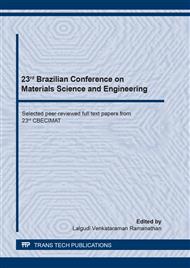p.447
p.453
p.461
p.466
p.471
p.477
p.483
p.489
p.494
Failure Analysis of Metallic Orthopedic Implant for Total Knee Replacement
Abstract:
Fractures resulting from wear and fatigue process have been identified as the main causes of failure in biomaterials, especially in implants that act in place of bone or other hard tissue, as they are subject to conditions involving severe cyclic loadings. In biomaterialscase, the types of failures mentioned above must also be evaluated under the effect of degradation or corrosion, due to the direct contact with body fluids. The present research analyzed the fatigue induced by corrosion fracture of an orthopaedic implant for total knee replacementproduced with an austenitic ASTM F138 stainless steel. The morphology, compositions of the interfaces and subsequent corrosive pitting were characterized by stereoscopy and scanning electron microscopy (SEM) coupled with energy dispersive spectroscopy (EDS). Stress concentration, inclusions and high carbon levels were the main reasons of failure.
Info:
Periodical:
Pages:
471-476
Citation:
Online since:
October 2020
Keywords:
Price:
Сopyright:
© 2020 Trans Tech Publications Ltd. All Rights Reserved
Share:
Citation:


